Abstract
Clostridium botulinum B-aphis spores plated on medium containing 4% salt at pH 6.0 yielded colonies at a frequency of ca. 1 in 10(6). A subculture of one of these colonies, designated strain Ba410, was compared with the parent strain, B-aphis, for a variety of traits. After 7 days of incubation at 37 degrees C, strain Ba410 grew in medium containing 7% NaCl, whereas strain B-aphis could not grow in salt concentrations greater than 5%. The strains also differed in cellular and colonial morphology. After exponential growth in the basal medium was completed, lysis of both strains was pH dependent; in media containing salt, lysis of Ba410 cells was pH independent. Strain Ba410 was more proteolytic than strain B-aphis in conditions of low pH and high salt, so that its toxin could be detected by the mouse assay. In a medium containing alanine and cysteine, the germination rate of B-aphis was 0.77% min-1, whereas that of Ba410 was 0.14% min-1; 2% salt inhibited the germination of Ba410 but not B-aphis.
Full text
PDF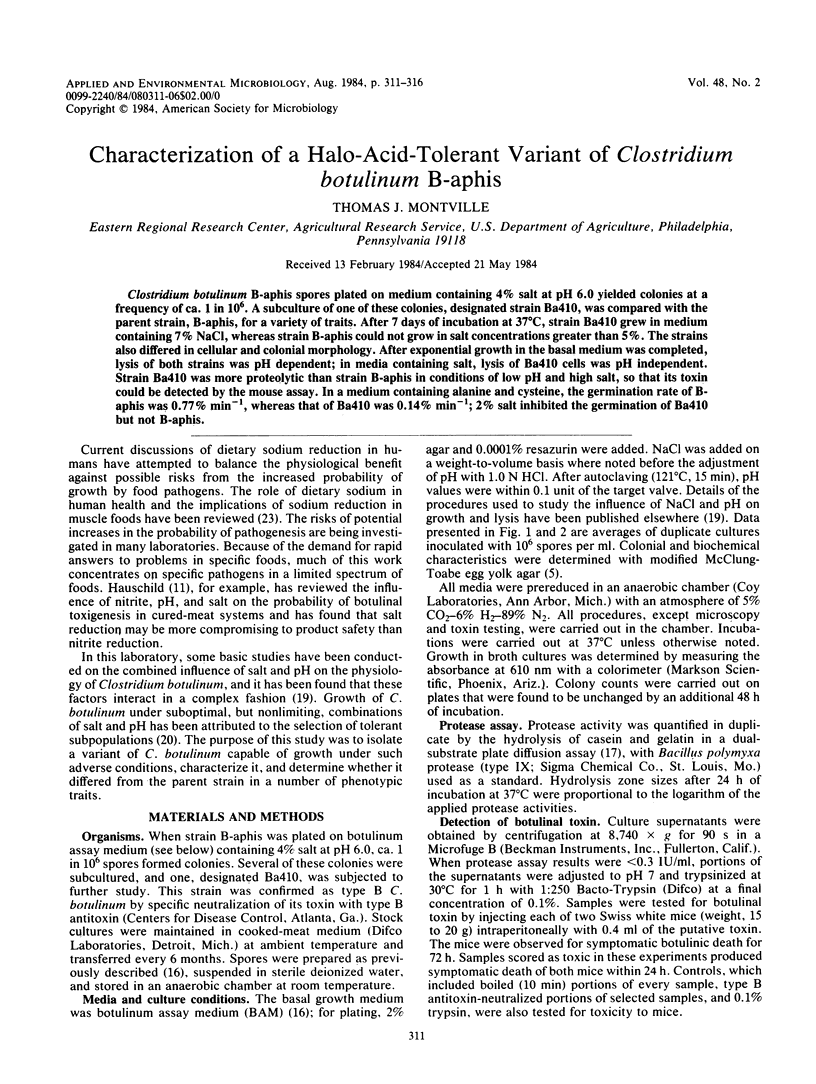
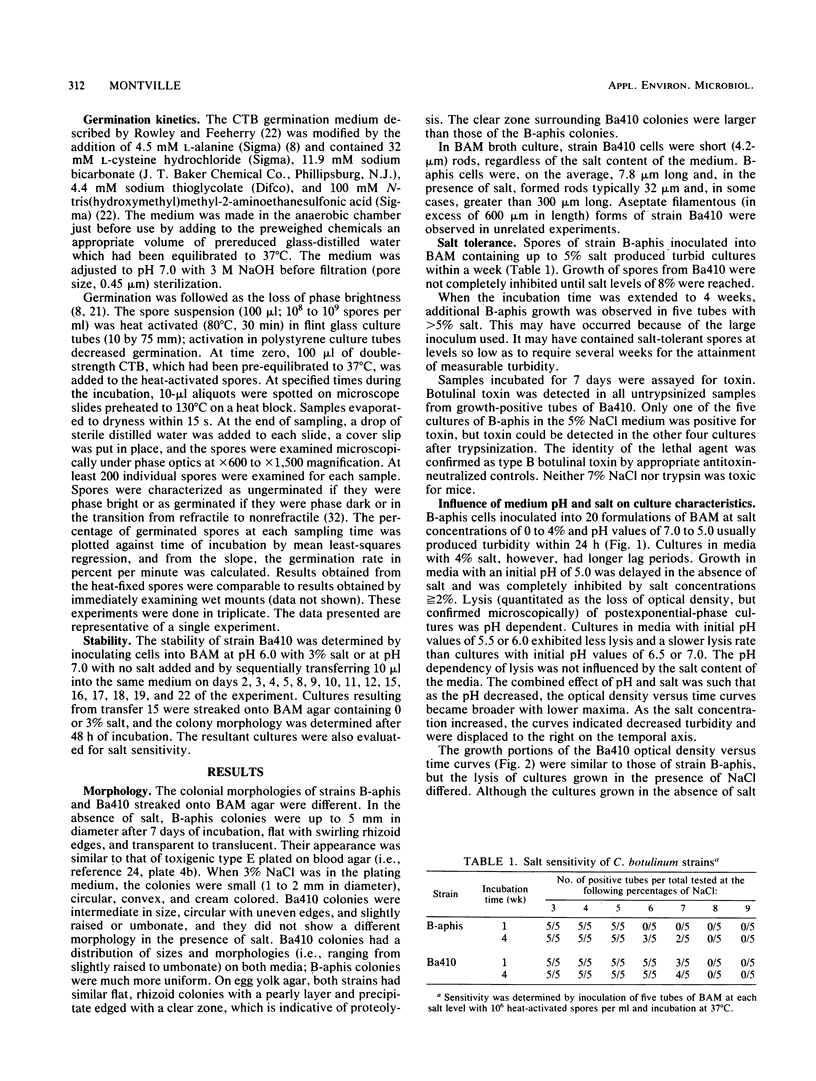
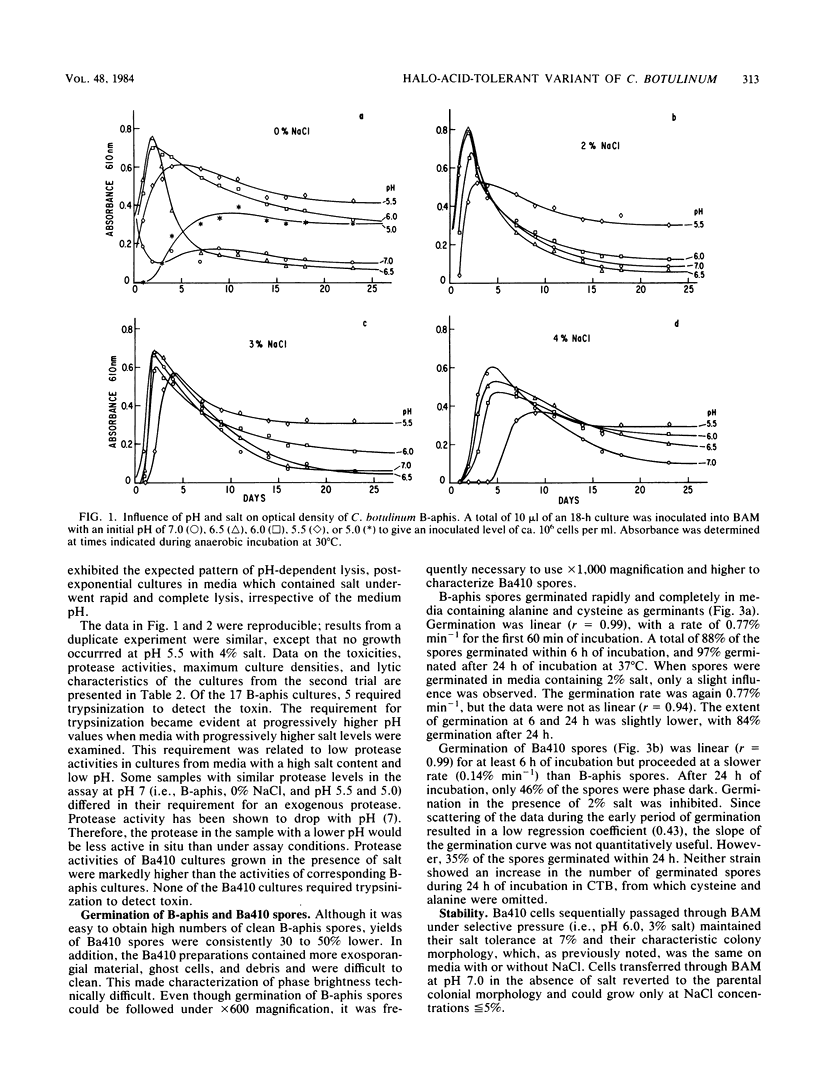
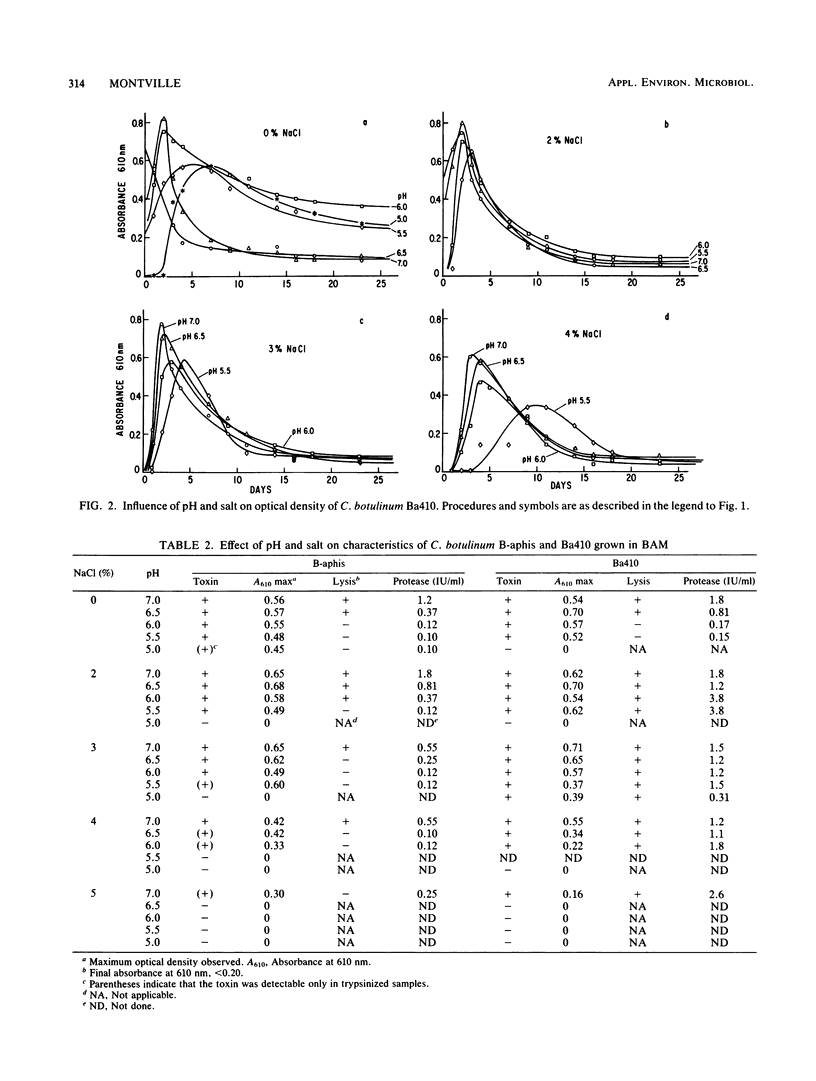
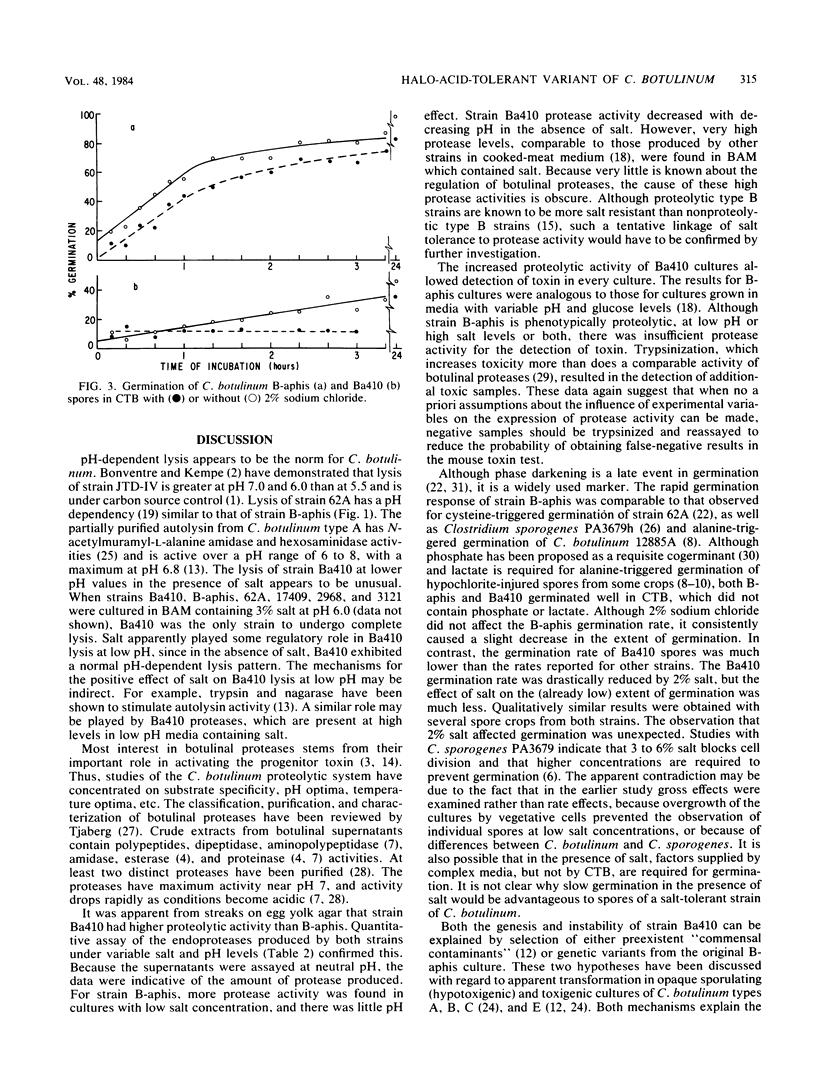
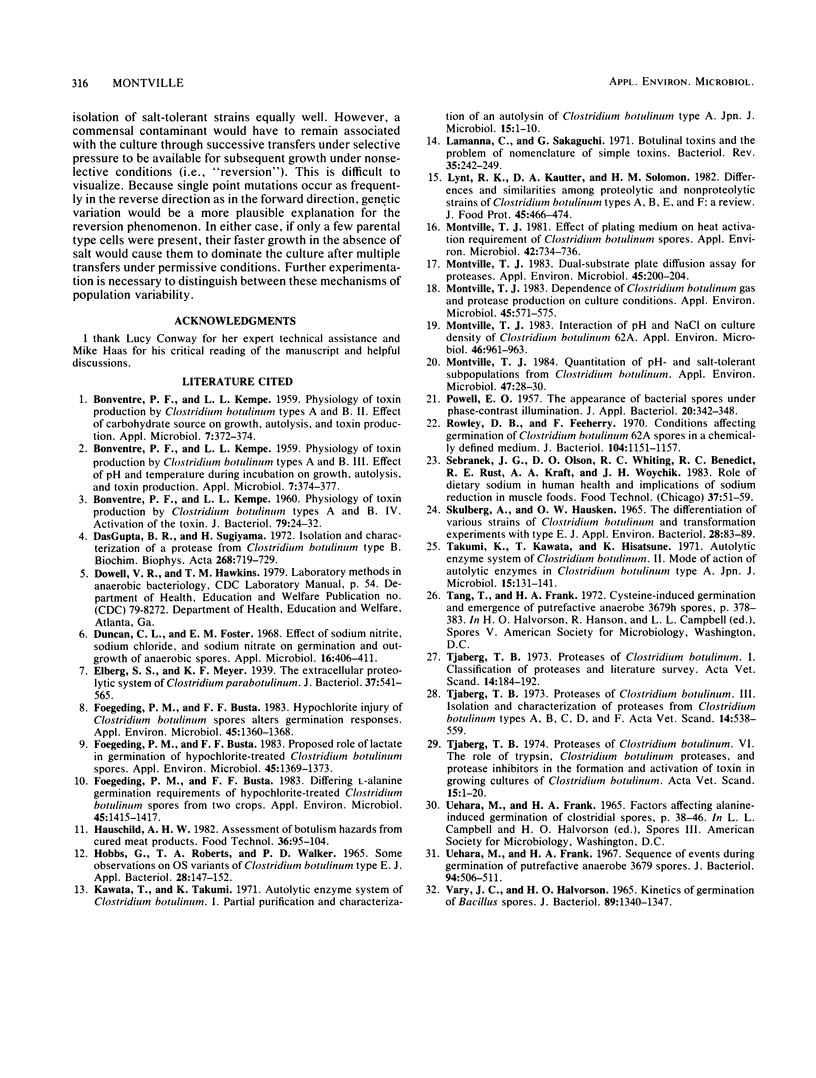
Selected References
These references are in PubMed. This may not be the complete list of references from this article.
- BONVENTRE P. F., KEMPE L. L. Physiology of toxin production by Clostridium botulinum types A and B. II. Effect of carbohydrate source on growth, autolysis, and toxin production. Appl Microbiol. 1959 Nov;7:372–374. doi: 10.1128/am.7.6.372-374.1959. [DOI] [PMC free article] [PubMed] [Google Scholar]
- BONVENTRE P. F., KEMPE L. L. Physiology of toxin production by Clostridium botulinum types A and B. III. Effect of pH and temperature during incubation on growth, autolysis. and toxin production. Appl Microbiol. 1959 Nov;7:374–377. doi: 10.1128/am.7.6.374-377.1959. [DOI] [PMC free article] [PubMed] [Google Scholar]
- BONVENTRE P. F., KEMPE L. L. Physiology of toxin production by Clostridium botulinum types A and B. IV. Activation of the toxin. J Bacteriol. 1960 Jan;79:24–32. doi: 10.1128/jb.79.1.24-32.1960. [DOI] [PMC free article] [PubMed] [Google Scholar]
- Dasgupta B. R., Sugiyama H. Isolation and characterization of a protease from Clostridium botulinum type B. Biochim Biophys Acta. 1972 Jun 16;268(3):719–729. doi: 10.1016/0005-2744(72)90276-8. [DOI] [PubMed] [Google Scholar]
- Duncan C. L., Foster E. M. Effect of sodium nitrite, sodium chloride , and sodium nitrate on germination and outgrowth of anaerobic spores. Appl Microbiol. 1968 Feb;16(2):406–411. doi: 10.1128/am.16.2.406-411.1968. [DOI] [PMC free article] [PubMed] [Google Scholar]
- Elberg S. S., Meyer K. F. The Extracellular Proteolytic System of Clostridium parabotulinum. J Bacteriol. 1939 May;37(5):541–565. doi: 10.1128/jb.37.5.541-565.1939. [DOI] [PMC free article] [PubMed] [Google Scholar]
- Foegeding P. M., Busta F. F. Differing L-alanine germination requirements of hypochlorite-treated Clostridium botulinum spores from two crops. Appl Environ Microbiol. 1983 Apr;45(4):1415–1417. doi: 10.1128/aem.45.4.1415-1417.1983. [DOI] [PMC free article] [PubMed] [Google Scholar]
- Foegeding P. M., Busta F. F. Hypochlorite injury of Clostridium botulinum spores alters germination responses. Appl Environ Microbiol. 1983 Apr;45(4):1360–1368. doi: 10.1128/aem.45.4.1360-1368.1983. [DOI] [PMC free article] [PubMed] [Google Scholar]
- Foegeding P. M., Busta F. F. Proposed role of lactate in germination of hypochlorite-treated Clostridium botulinum spores. Appl Environ Microbiol. 1983 Apr;45(4):1369–1373. doi: 10.1128/aem.45.4.1369-1373.1983. [DOI] [PMC free article] [PubMed] [Google Scholar]
- Grondalen T. Osteochondrosis and arthrosis in pigs. I. Incidence in animals up to 120 kg live weight. Acta Vet Scand. 1974;15(1):1–25. doi: 10.1186/BF03547490. [DOI] [PMC free article] [PubMed] [Google Scholar]
- Kawata T., Takumi K. Autolytic enzyme system of Clostridium botulinum. I. Partial purification and characterization of an autolysin of Clostridium botulinum type A. Jpn J Microbiol. 1971 Jan;15(1):1–10. [PubMed] [Google Scholar]
- Lamanna C., Sakaguchi G. Botulinal toxins and the problem of nomenclature of simple toxins. Bacteriol Rev. 1971 Sep;35(3):242–249. doi: 10.1128/br.35.3.242-249.1971. [DOI] [PMC free article] [PubMed] [Google Scholar]
- Montville T. J. Dependence of Clostridium botulinum gas and protease production on culture conditions. Appl Environ Microbiol. 1983 Feb;45(2):571–575. doi: 10.1128/aem.45.2.571-575.1983. [DOI] [PMC free article] [PubMed] [Google Scholar]
- Montville T. J. Dual-substrate plate diffusion assay for proteases. Appl Environ Microbiol. 1983 Jan;45(1):200–204. doi: 10.1128/aem.45.1.200-204.1983. [DOI] [PMC free article] [PubMed] [Google Scholar]
- Montville T. J. Effect of plating medium on heat activation requirement of Clostridium botulinum spores. Appl Environ Microbiol. 1981 Oct;42(4):734–736. doi: 10.1128/aem.42.4.734-736.1981. [DOI] [PMC free article] [PubMed] [Google Scholar]
- Montville T. J. Interaction of pH and NaCl on culture density of Clostridium botulinum 62A. Appl Environ Microbiol. 1983 Oct;46(4):961–963. doi: 10.1128/aem.46.4.961-963.1983. [DOI] [PMC free article] [PubMed] [Google Scholar]
- Montville T. J. Quantitation of pH- and salt-tolerant subpopulations from Clostridium botulinum. Appl Environ Microbiol. 1984 Jan;47(1):28–30. doi: 10.1128/aem.47.1.28-30.1984. [DOI] [PMC free article] [PubMed] [Google Scholar]
- Rowley D. B., Feeherry F. Conditions Affecting Germination of Clostridium botulinum 62A Spores in a Chemically Defined Medium. J Bacteriol. 1970 Dec;104(3):1151–1157. doi: 10.1128/jb.104.3.1151-1157.1970. [DOI] [PMC free article] [PubMed] [Google Scholar]
- Takumi K., Kawata T., Hisatsune K. Autolytic enzyme system of Clostridium botulinum. II. Mode of action of autolytic enzymes in Clostridium botulinum type A. Jpn J Microbiol. 1971 Mar;15(2):131–141. doi: 10.1111/j.1348-0421.1971.tb00562.x. [DOI] [PubMed] [Google Scholar]
- Tjaberg T. B. Proteases of Clostridium botulinum. 3. Isolation and characterization of proteases from Clostridium botulinum types A,B,C,D and F. Acta Vet Scand. 1973;14(4):538–559. [PubMed] [Google Scholar]
- Tjaberg T. B. Proteases of Clostridium botulinum. I. Classification of proteases and literature survey. Acta Vet Scand. 1973;14(1):184–192. doi: 10.1186/BF03547421. [DOI] [PMC free article] [PubMed] [Google Scholar]
- Uehara M., Frank H. A. Sequence of events during germination of putrefactive anaerobe 3679 spores. J Bacteriol. 1967 Sep;94(3):506–511. doi: 10.1128/jb.94.3.506-511.1967. [DOI] [PMC free article] [PubMed] [Google Scholar]
- VARY J. C., HALVORSON H. O. KINETICS OF GERMINATION OF BACILLUS SPORES. J Bacteriol. 1965 May;89:1340–1347. doi: 10.1128/jb.89.5.1340-1347.1965. [DOI] [PMC free article] [PubMed] [Google Scholar]


